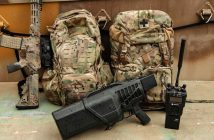
Intelligence, Surveillance and Reconnaissance (ISR) missions are rarely executed in controlled laboratory environments — quite the opposite. The platforms — from airborne drones to terrestrial and underwater remotely piloted vehicles (RPVs) — that carry ISR payloads are often deployed in the harshest conditions and connected to users and operators over wildly inconsistent communication networks.
The ability to ensure high-quality images, regardless of network conditions in a theatre of operations, has emerged as a critical success factor for ISR activities that depend on video-based intelligence to establish situational awareness and support effective decision-making.
This is where Change-Bitrate-on-the-Fly technology comes in.
Here, Mark Rushton, Global Defense and Security Lead at VITEC shares his insights on how Change-Bitrate-on-the-Fly technology improves ISR mission success rates.
Change-Bit-Rate-on-the-Fly technology: what is it and why is it essential to the ISR mission?
When talking about video streaming, we often focus on bitrates, which are measured by considering how many frames are taken every second, along with the size of each frame. The higher the video quality, the more images are needed to process for each second of video, which, of course, results in higher bitrate requirements.
Change-Bit-Rate-on-the-Fly technology is an increasingly important feature for the ISR community because it directly affects the quality and timeliness of tactical field intelligence. Receiving information too late because of network latency or being unable to understand what is being analyzed because of dropped packets that result in fuzzy or pixelated images can mean the difference between life and death.
In many ways, the need for Change-Bit-Rate-on-the-Fly capabilities reflects the technological progress that has allowed more sensors with greater capacity to be loaded on ISR platforms — such as drones or helicopters. Innovations around ISR have led to cameras that capture video images in stunning detail and sensors capable of detecting subtle temperature changes in the environment, including ground-penetrating radar. As a result, more information can be shared from a single ISR platform than before.
It does, however, create a challenge.
While devices to capture this wide array of data are becoming increasingly advanced, there are still challenges associated with the wireless networks used to access the data in terms of bandwidth, capability and change.
Change-Bit-Rate-on-the-Fly is a technology can help address network constraints by adapting the bitrate as it changes.
What challenges leads to network constraints or variability?
The ISR community has done a lot of excellent work in adopting standards across the technical elements needed to capture, share and act on digital intelligence. As a result, most platform and payload technologies can use almost any wireless network in the field to maintain connectivity — and, therefore, the flow of intelligence.
The agility and flexibility that enable drones and other RPVs to use multiple networks means these platforms can dynamically switch from a cellular network to a satellite link and then to a terrestrial mesh network.
However, as these platforms shift from one data carrier to another, they will likely experience a difference in bandwidth available to support the data traffic. Sometimes, that delta can be quite significant. A cellular network might deliver up to 100 megabits in connectivity only to switch to a satellite signal that supports a fraction of that capacity.
The other challenge revolves around the roving nature of ISR platforms. The quality and strength of wireless signals are better when platforms are near antennas. The signals weaken as the distance from antennas grows.
While the connectivity environment is highly dynamic – with bandwidth fluctuating from total capacity, only to be cut by half and then a third of capacity — the overall ISR objective of sharing the highest quality image possible remains the same.
That’s why Change-Bitrate-on-the-Fly is a differentiator for IP video applications on ISR platforms. With it, we can make changes dynamically in real-time to ensure the continuity of images at the highest possible quality. This can’t be underscored enough because video in a live environment is crucial for ISR. It represents a major improvement over the previous ISR video capabilities. With Change-Bitrate-on-the-Fly, ISR teams can execute their missions with confidence.






